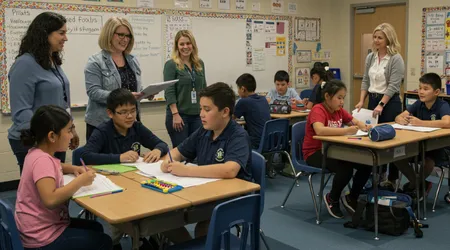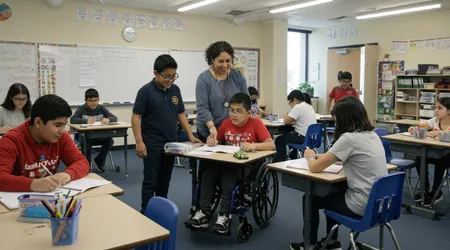Pilots of inclusive education models like Maine’s new program

Pilots of inclusive education models are reshaping how schools approach learning for all students, particularly those with disabilities.
In 2025, Maine’s innovative five-year pilot program, launched in three elementary schools Downeast in Bangor, Turner, and Leeds Central stands as a beacon of progress.
Backed by federal funding from the Individuals with Disabilities Education Act (IDEA) and partnered with the University of Maine, this initiative seeks to dismantle outdated silos that segregate special education students.
Why should we continue separating students when we can foster classrooms where everyone thrives together?
This article delves into Maine’s trailblazing effort, exploring its mechanics, challenges, and potential to redefine education globally.
Inclusive education isn’t just a buzzword; it’s a movement toward equity and community. Maine’s program, rooted in real-world application, offers a blueprint for integrating diverse learners.
By focusing on teacher training, schedule restructuring, and collaborative teaching, it aims to ensure special education students spend more time in general classrooms.
This shift promises not only academic benefits but also social growth, preparing students for a world that values connection over division. Let’s unpack this transformative approach, its implications, and what it means for the future of education.
The Genesis of Maine’s Inclusive Education Pilot
Maine’s pilots of inclusive education models address a pressing need. With 21% of its students requiring special education second only to Puerto Rico, tied with New York and Pennsylvania the state faces unique challenges.
Historically, only 56% of Maine’s special education students spent most of their day in general classrooms, lagging 10% behind the national average (National Center for Education Statistics, 2023). This gap sparked urgency for reform, leading to the pilot’s creation.
The program, launched in August 2025, targets three elementary schools with high special education populations. Downeast School, for instance, serves a third of its students with disabilities.
Principal Sarah Vickers emphasizes collaboration across departments to address diverse needs. By equipping teachers with inclusive strategies, the pilot aims to create classrooms where all students learn side by side.
++ UNESCO’s Roadmap for Inclusive Education: What’s New
This isn’t just about compliance with IDEA; it’s about reimagining education as a shared journey.
Funding from federal grants and the University of Maine partnership fuels this initiative. While exact costs remain undisclosed, the investment signals a commitment to long-term change.
The pilot’s first year focuses on training teachers to adapt curricula for diverse learners, aiming for 80% of special education students to spend 80% of their day in general settings. This ambitious goal reflects a belief that inclusion benefits everyone, not just those with disabilities.

Why Inclusion Matters: Breaking Down Silos
The push for pilots of inclusive education models stems from a moral and practical imperative. Segregating students with disabilities creates artificial barriers, limiting their exposure to peer role models and real-world expectations.
Atlee Reilly from Disability Rights Maine argues that preparing students for community life employment, further education requires integrated settings from the start. Why isolate children in environments that don’t mirror the world they’ll enter?
Inclusion fosters social growth. Carrie Woodcock, executive director of the Maine Parent Federation, shares her daughter Sami’s story.
Integrated classrooms allowed Sami to learn alongside peers, who became informal teachers, enhancing her social skills.
Also read: Inclusive Education in 2025: Global Best Practices You Should Know
This peer-driven learning model reduces the stigma of disability and builds empathy among all students. Maine’s pilot, by prioritizing general classroom time, aims to replicate these benefits on a broader scale.
Beyond social gains, inclusion addresses financial strain. Maine’s special education costs are skyrocketing, driven by private school placements costing hundreds daily.
The Maine Education Policy Research Institute (MEPRI) notes that challenging behaviors increase referrals, exacerbating costs and teacher shortages.
By embedding supports in general classrooms, the pilot seeks to reduce reliance on costly external programs, making inclusion a practical solution.
How Maine’s Pilot Works: A Practical Blueprint
Maine’s pilots of inclusive education models hinge on practical, scalable strategies. Teacher training forms the backbone, equipping educators to differentiate instruction for diverse learners.
At Turner Elementary, teachers learn to adapt lessons for multiple learning styles, ensuring accessibility without segregation. This approach aligns with universal design principles, benefiting all students, not just those with disabilities.
Schedule restructuring is another key component. Leeds Central School, for example, adjusts timetables to maximize special education students’ time in general classrooms.
Collaborative teaching models where general and special education teachers co-plan and co-teach create seamless learning environments. This teamwork reduces the isolation often felt by students with disabilities, fostering a sense of belonging.
Read more: How AI-Powered Personalized Learning is Transforming Inclusive Education
The pilot also tackles over-identification of special education needs. MEPRI reports that weak early identification leads to over-referrals later, inflating costs.
By enhancing general classroom supports, the program aims to decrease unnecessary special education placements. This data-driven approach ensures resources focus on students who truly need them, optimizing educational outcomes.
| Component | Description | Goal |
|---|---|---|
| Teacher Training | Professional development in inclusive strategies and differentiated instruction | Equip teachers to meet diverse needs in general classrooms |
| Schedule Restructuring | Adjust school schedules to increase general classroom time | Ensure 80% of special ed students spend 80% of day in general settings |
| Collaborative Teaching | General and special ed teachers co-plan and co-teach | Create seamless, inclusive learning environments |
| Reduced Over-Identification | Strengthen early identification to minimize unnecessary referrals | Lower special education costs and improve resource allocation |
Challenges and Opportunities in Scaling Inclusion
Implementing pilots of inclusive education models isn’t without hurdles. Scaling Maine’s program statewide requires overcoming entrenched practices and funding constraints.
Atlee Reilly notes that financial incentives often drive schools to send students to private placements. Shifting this paradigm demands robust policy changes, rewarding schools for inclusive practices.
Teacher shortages pose another challenge. MEPRI highlights that challenging behaviors strain staff, increasing burnout. The pilot’s training component aims to mitigate this by equipping educators with proactive behavior management strategies.
For example, Downeast School uses positive behavioral interventions to address disruptions, reducing referrals and supporting teacher retention.
Yet, opportunities abound. The pilot’s success could inspire national reform. By demonstrating that inclusive classrooms reduce costs and improve outcomes, Maine could influence federal education policy.
The April 2025 Inclusive Education Conference, hosted by Maine DOE, showcased these possibilities, uniting educators and advocates to share best practices. Scaling these lessons could transform education beyond Maine’s borders.
The Ripple Effect: Social and Academic Benefits

The impact of pilots of inclusive education models extends beyond academics. Socially, inclusive classrooms build empathy and collaboration.
At Leeds Central, students like Mia, a hypothetical third-grader with autism, learn alongside peers, gaining confidence through group projects. Her classmates, in turn, develop patience and leadership, enriching the classroom dynamic.
Academically, inclusion drives excellence. A 2018 study by the National Center for Learning Disabilities found that students with disabilities in inclusive settings scored 15% higher on standardized tests than those in segregated environments.
Maine’s pilot aims to replicate this, using data to refine teaching strategies. By fostering peer learning, students without disabilities also benefit, as teaching others reinforces their own understanding.
Imagine a garden where every plant, regardless of type, thrives in shared soil. This is the promise of inclusion diverse learners growing together, each contributing to a vibrant ecosystem.
Maine’s pilot, by nurturing this environment, sets a precedent for schools nationwide, proving that inclusion is not just ethical but transformative.
A Vision for the Future: Policy and Practice
The success of pilots of inclusive education models hinges on sustainable policy. Maine’s lawmakers have faced challenges, with bills like L.D. 933 failing to secure additional special education funding.
The pilot’s federal backing offers a temporary lifeline, but long-term success requires state-level investment. Schools need resources to sustain training and infrastructure changes.
Community buy-in is equally critical. Resistance to tax increases, as seen in some Maine towns, complicates funding.
The pilot counters this by demonstrating cost savings through reduced private placements. By engaging families, like Carrie Woodcock’s, in advocacy, the program builds grassroots support, ensuring its longevity.
Looking ahead, Maine’s model could inspire global innovation. Countries like Finland, known for inclusive education, integrate 90% of special needs students in general classrooms.
Maine’s pilot, while smaller, aligns with this vision, offering a scalable framework. By 2030, it could redefine how schools balance equity and efficiency, setting a global standard.
Conclusion: A Call to Reimagine Education
Maine’s pilots of inclusive education models are more than an experiment they’re a bold reimagining of what education can be.
By prioritizing inclusion, the state challenges decades of segregation, proving that all students can thrive together.
The pilot’s focus on training, collaboration, and data-driven reform offers a roadmap for schools worldwide. Its success could lower costs, reduce teacher burnout, and, most importantly, empower students to reach their full potential.
This isn’t just about classrooms; it’s about building communities where everyone belongs. As Maine’s pilot unfolds, it invites us to rethink education’s purpose: not to divide, but to unite.
The journey is just beginning, but the destination a world where every learner is valued is worth pursuing. Will we seize this opportunity to create schools that reflect the diverse, interconnected world we live in?
Frequently Asked Questions
What are pilots of inclusive education models?
They’re programs, like Maine’s, testing ways to integrate special education students into general classrooms, focusing on teacher training and collaboration.
How does Maine’s pilot program work?
It trains teachers, restructures schedules, and promotes co-teaching in three elementary schools to include special education students in general settings.
Why is inclusive education important?
It fosters social and academic growth, reduces stigma, and prepares all students for diverse communities, while potentially lowering special education costs.
What challenges does the pilot face?
Teacher shortages, funding constraints, and resistance to change are hurdles, but training and policy reform aim to address these issues.
Can Maine’s model be scaled nationally?
Yes, with sufficient funding and policy support, its focus on practical, inclusive strategies could inspire reform across the U.S. and beyond.
